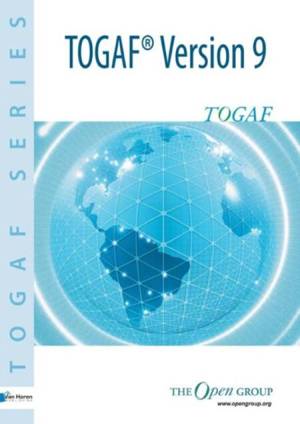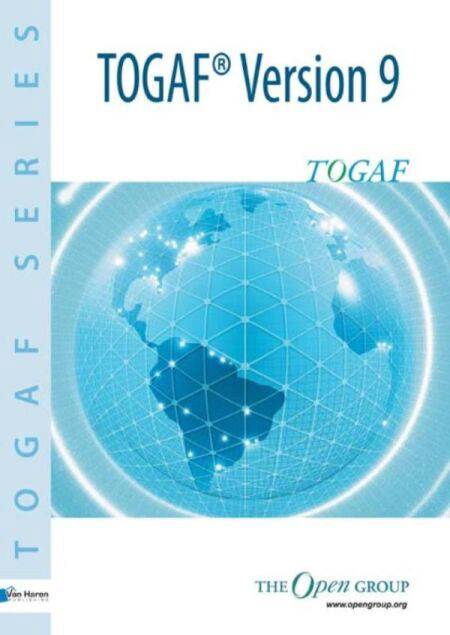
- Retrait gratuit dans votre magasin Club
- 7.000.000 titres dans notre catalogue
- Payer en toute sécurité
- Toujours un magasin près de chez vous
- Retrait gratuit dans votre magasin Club
- 7.000.0000 titres dans notre catalogue
- Payer en toute sécurité
- Toujours un magasin près de chez vous
Description
This is the Official Hardcopy publication of The Open Group Architecture Framework
TOGAF is a framework - a detailed method and a set of supporting tools - for developing an enterprise architecture, developed by members of The Open Group Architecture Forum.
TOGAF Version 9 provides a wide-ranging set of revisions to the TOGAF specification to improve the value of the TOGAF framework. It is an evolution from TOGAF 8.1.1, thereby preserving existing investment in TOGAF, and adds further detail and clarification to what is already proven.
It may be used freely by any organization wishing to develop an enterprise architecture for use within that organization (subject to the Conditions of Use).
In this book, you will find answers to questions such as: What is an architecture framework? What kind of 'architecture' are we talking about? How does my organization benefit from using TOGAF?
This Book is divided into seven main parts:
Part I - Introduction
This part provides a high-level introduction to the key concepts of enterprise architecture and in particular the TOGAF approach. It contains the definitions of terms used throughout TOGAF and release notes detailing the changes between this version and the previous version of TOGAF.
Part II - Architecture Development Method
This is the core of TOGAF. It describes the TOGAF Architecture Development Method (ADM) a step-by-step approach to developing an enterprise architecture.
Part III - ADM Guidelines & Techniques
This part contains a collection of guidelines and techniques available for use in applying TOGAF and the TOGAF ADM.
Part IV - Architecture Content Framework
This part describes the TOGAF content framework, including a structured metamodel for architectural artifacts, the use of re-usable architecture building blocks, and an overview of typical architecture deliverables.
Part V - Enterprise Continuum & Tools
This part discusses appropriate taxonomies and tools to categorize and store the outputs of architecture activity within an enterprise.
Part VI - TOGAF Reference Models
This part provides a selection of architectural reference models, which includes the TOGAF Foundation Architecture, and the Integrated Information Infrastructure Reference Model (III-RM).
Part VII - Architecture Capability Framework
This partdiscusses the organization, processes, skills, roles, and responsibilities required to establish and operate an architecture function within an enterprise.
TOGAF is a framework - a detailed method and a set of supporting tools - for developing an enterprise architecture, developed by members of The Open Group Architecture Forum.
TOGAF Version 9 provides a wide-ranging set of revisions to the TOGAF specification to improve the value of the TOGAF framework. It is an evolution from TOGAF 8.1.1, thereby preserving existing investment in TOGAF, and adds further detail and clarification to what is already proven.
It may be used freely by any organization wishing to develop an enterprise architecture for use within that organization (subject to the Conditions of Use).
In this book, you will find answers to questions such as: What is an architecture framework? What kind of 'architecture' are we talking about? How does my organization benefit from using TOGAF?
This Book is divided into seven main parts:
Part I - Introduction
This part provides a high-level introduction to the key concepts of enterprise architecture and in particular the TOGAF approach. It contains the definitions of terms used throughout TOGAF and release notes detailing the changes between this version and the previous version of TOGAF.
Part II - Architecture Development Method
This is the core of TOGAF. It describes the TOGAF Architecture Development Method (ADM) a step-by-step approach to developing an enterprise architecture.
Part III - ADM Guidelines & Techniques
This part contains a collection of guidelines and techniques available for use in applying TOGAF and the TOGAF ADM.
Part IV - Architecture Content Framework
This part describes the TOGAF content framework, including a structured metamodel for architectural artifacts, the use of re-usable architecture building blocks, and an overview of typical architecture deliverables.
Part V - Enterprise Continuum & Tools
This part discusses appropriate taxonomies and tools to categorize and store the outputs of architecture activity within an enterprise.
Part VI - TOGAF Reference Models
This part provides a selection of architectural reference models, which includes the TOGAF Foundation Architecture, and the Integrated Information Infrastructure Reference Model (III-RM).
Part VII - Architecture Capability Framework
This partdiscusses the organization, processes, skills, roles, and responsibilities required to establish and operate an architecture function within an enterprise.
Spécifications
Parties prenantes
- Auteur(s) :
- Editeur:
Contenu
- Langue:
- Anglais
- Collection :
Caractéristiques
- EAN:
- 9789087535995
- Date de parution :
- 27-02-11
- Format:
- Ebook
- Protection digitale:
- Digital watermarking
- Format numérique:

Les avis
Nous publions uniquement les avis qui respectent les conditions requises. Consultez nos conditions pour les avis.






